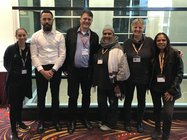
One of the more notable events during the recent AHA Conference in Toowoomba (8th-12th July) was a panel on the neglected history of urban Aboriginal camps. The concept – Aboriginal Cities – was developed by Dr Paul Irish (Coast History & Heritage, Sydney), working with fellow historians Dr Denise Cook (Deakin University, based in Perth) and Dr Ray Kerkhove (a former HGRC Fellow, now UQ, Brisbane). All three had written books on this topic concerning their respective cities. The presentation was given in collaboration with representatives from the respective Aboriginal communities (Michael Ingrey for Sydney; Lynnette Coomer for Perth and Deborah Sandy for Brisbane). Thus it offered both an academic and lived perspective. Paul Irish and Michael Ingrey spoke about the ways that Aboriginal people in Sydney adapted to the expanding colony on their doorstep, finding new ways to live while retaining their cultural connections. Michael spoke of his ancestor’s connections, highlighting the way that knowledge of the historical Sydney camps has been kept alive in the community. Denise Cook highlighted the significance of the camps in the shared history of Perth’s suburbs until at least the 1950s, the importance for historians in following Aboriginal cultural protocols, and the value of shared story-telling. Lynnette Coomer spoke of her memories of living with her extended family in the Shenton Park camps as a child in the 1950s, including getting water, collecting flowers with her grandmother to sell, and going to the local primary school. Deborah Sandy spoke about the importance of particular camps in Brisbane, and her daughter Rheanne Sandy presented for Ray Kerkhove (who could not be there). Ray’s paper focused on the evidence for Brisbane’s green spaces evolving from traditional campsites, and the historical impact of these sites well into recent times.


